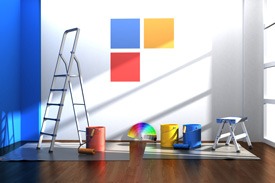Types of Sheen
What types of sheen should I use?
Just when you finally finished picking the colors for your painting project, you realize that you still need to pick the type of paint you want! Avoid letting confusion set in by reading below to help you decide between flat paint, satin or eggshell paint, semi-gloss or gloss.
Paint sheen simply means the level of glossiness in paint. Today, most paints come in one of the following sheens: flat, satin or eggshell, semi-gloss and gloss.

Flat Paint
The standard for most walls. It has the lowest sheen available and when it dries, it appears completely non-reflective with a smooth, matte finish. Flat paints are great because they conceal imperfections on walls that were there before you painted – as well as imperfections that occur after you paint. Flat paint can help to make the surfaces look smoother and more uniform, and if the wall or surface gets any scratches, you won’t have to worry so much, as nicks and scratches blend in fairly well to flat paint!
Satin, or Eggshell Paint
Also known as low-luster paint. While these paints are low-luster, they are more lustrous than flat paint and have a nice, slight sheen when compared to flat paint. The slight sheen is what makes eggshell paint able to bring a warm look and feel – and depth – to a room. This kind of paint is also easier to clean and can be used on any wall in your home. Paint a small area of a wall with eggshell paint to make sure this look what you want to achieve.
Semi-Gloss Paint
Very popular when painting trim and doors throughout a home. Semi-gloss is extremely durable and easy to clean. Keep in mind that semi-gloss paints show a lot of imperfections, so if you have imperfect walls or trim you may want to weigh out the pros and cons.
Gloss Paint
The toughest and most durable of all paints – and the shiniest, too! This very high sheen paint is often used on doors or cabinets and in areas susceptible to getting dirty. It is also used on trim, baseboards and door frames.
